Charles Gaines "Moving Chains" in collaboration with TOLO Architecture.
We began working with Charles Gaines when he asked us to collaborate on an invited competition organized by Creative Time for a large public sculpture to be sited at the base of the Gateway Arch along the Mississippi River in Saint Louis, Missouri. The project Charles’ had in mind was of a monumental scale (Charles is not shy about thinking big!) and he thought we would be able to help him realize his vision. While that version of the project was not realized, the piece by now called “Moving Chains” was adapted for a new site on Governors Island, south of Manhattan. That piece, the result of an 8-year effort, opened to the public in October 2022.
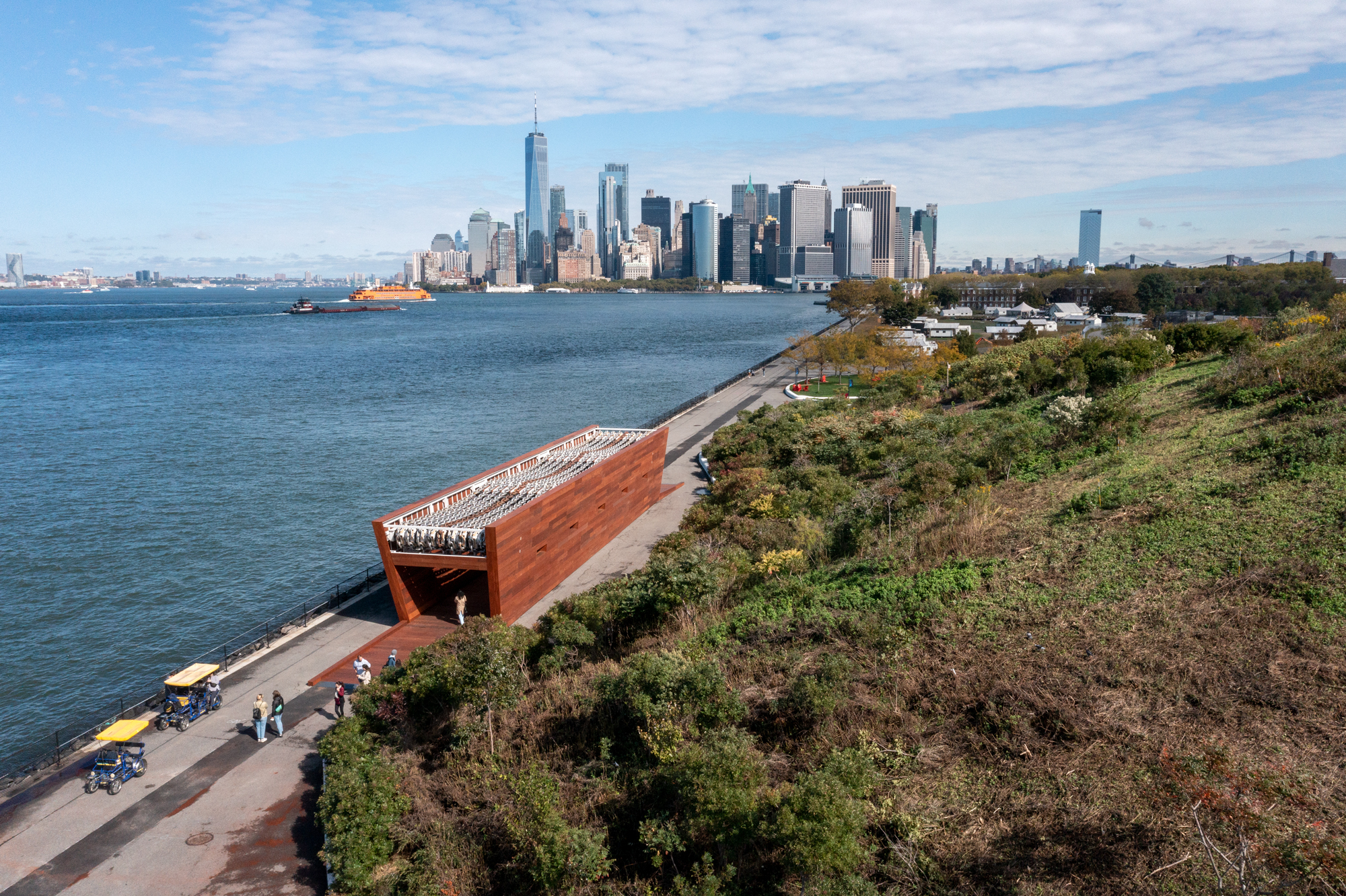
Photograph by Timothy Schenk
Charles describes Moving Chains as a “metaphorical structure.” That is part of the reason we’ve found it is so interesting to collaborate with him. While architecture can have symbolic meaning, many buildings refer to historic precedent, it is rare that the meaning is so frontally charged. For us that means that all design decisions on this project needed be at the service of conveying a highly specific meaning, from the inclination of the vessel’s walls to the patina on the chains.
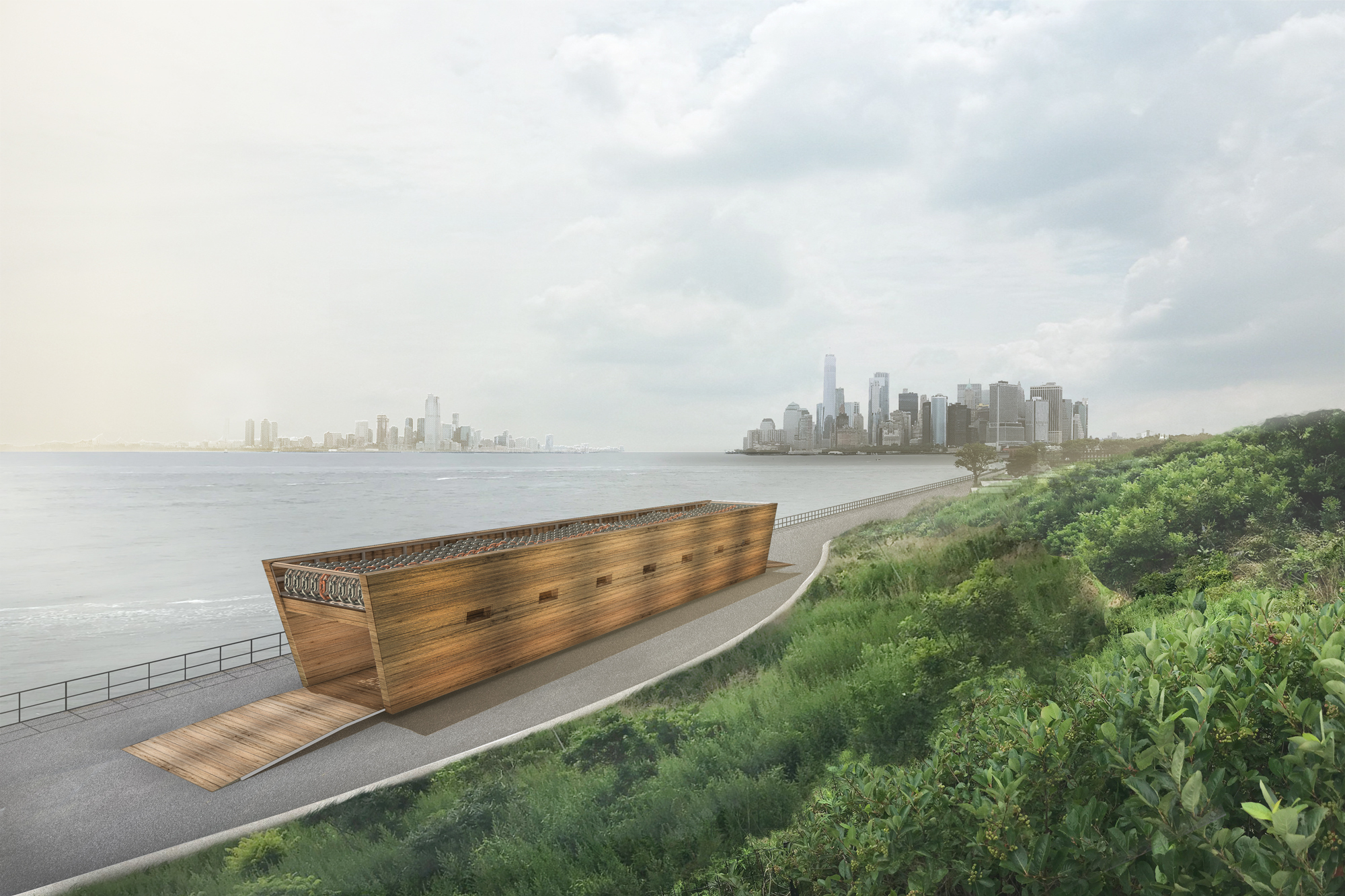
Charles has described the work as engaging the two central narratives:
"One is the barge itself. The second structure is located on top of the barge, where we find nine chain links, each running the length of the barge. The chains are moving… The outer chains move at the speed of the river current along the east river where this work is installed. The center chain moves at the speed of the commercial barges of the 19th century that traversed the rivers at the time. Cited on Governors island, the barge can be seen from a bank that gives a view of it and the river; this reinforces the river metaphor. And it can be seen at ground level where it references the commercial barges of the 18th century. At this level one can enter it to get the experience of being in a slave ship, linking the slave passage to the commerce of commodities. The massive chains overhead can be seen from inside and the sound of the chains can be experienced both outside and inside, adding an intense drama to the experience, giving a perspective of the experience of slaves who were trapped in the cargo hold of the ships."
The process of working with Charles Gaines was highly collaborative… it began with a discussion, followed by a presentation, more discussions, more revision, …and so on. Charles is an artist that has clearly defined conceptual boundaries for the pieces he envisions, which in turn made our work helping to develop the form and materiality of the project easier. We have also benefited from a long-standing relationship working with Charles, including designing his studio and renovating his own home.
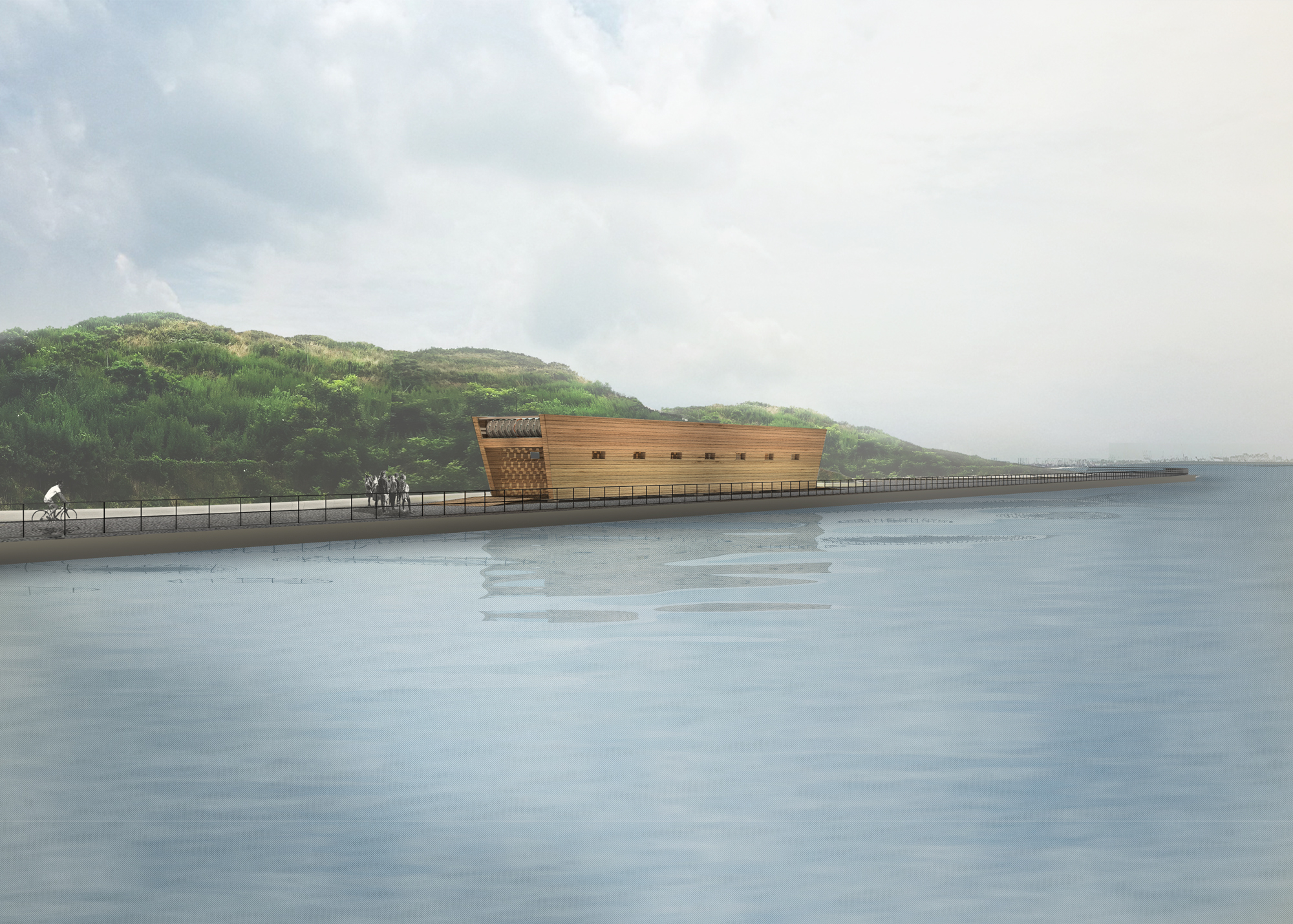
While not a boat, Moving Chains is sited at the edge of the water and its shape refers to the wooden barges that historically moved goods and services along this country’s rivers. To determine the canted form and cladding of the piece, we also studied historic slave ship images and model reconstructions. Although being open at bow and stern as a boat, Moving Chains would immediately sink if placed in the water. In researching architectural section drawings of slave ships one of the most striking aspects of these, was the vertical separation between the holds housing cargo, slaves and crew. The space for slaves was highly compressed, a person would be unable to stand up straight in such a space, and there was also very limited access to light, air or view.
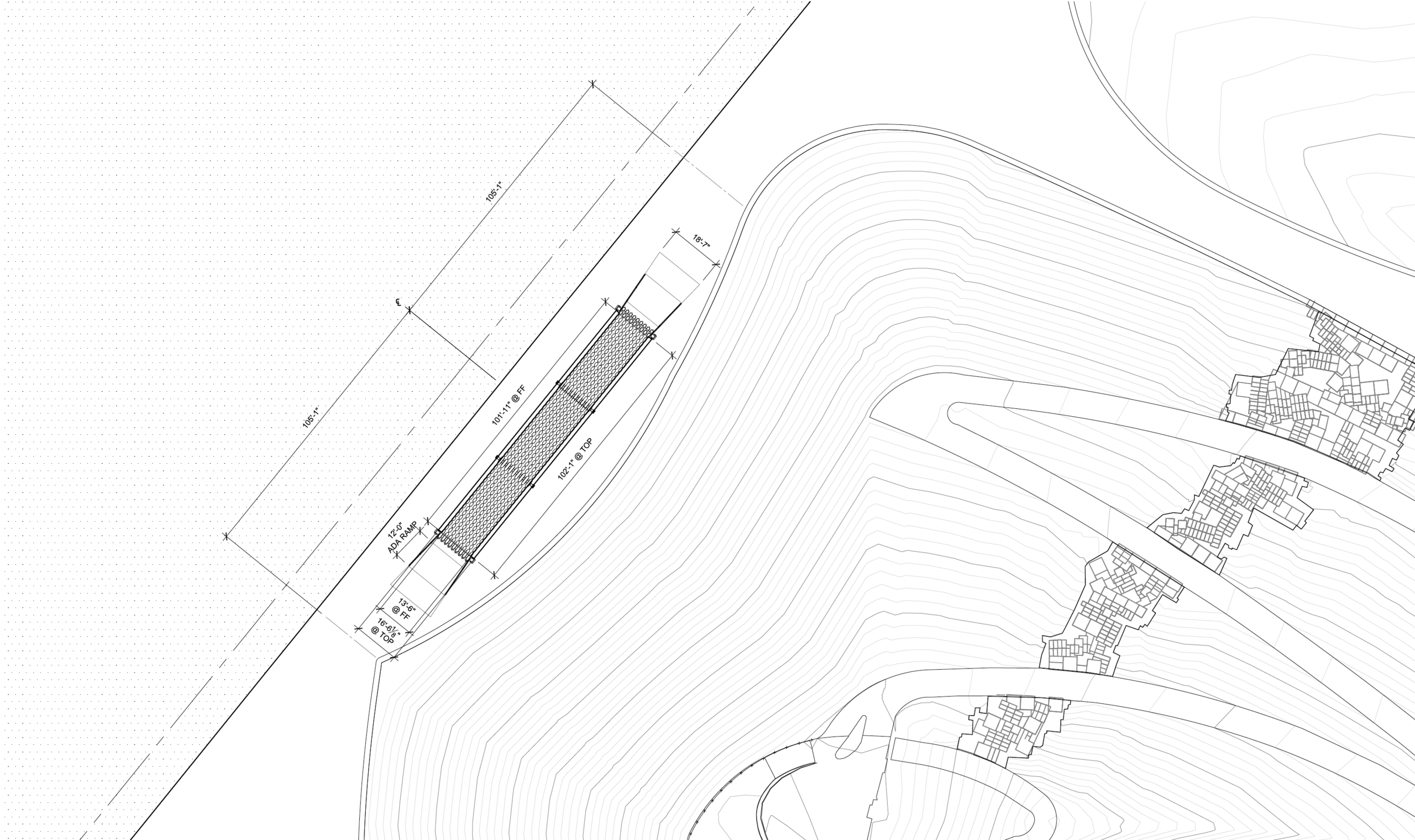
Site plan of Moving Chains vessel on Governors Island.
In Moving Chains there is a clear separation between the occupied lower level that the public moves through and the level that houses the chain assembly. Small linear portholes are situated above view height designed to focus the viewer inward and to experience the chains moving above. And then there are the chains themselves, referencing the shackling of slaves and the anchoring ships. There is also the more direct refence to the moving of the river in the nine chains at the perimeter and at the center, one chain moves faster, at the speed of a barge moving its entangled cargo.
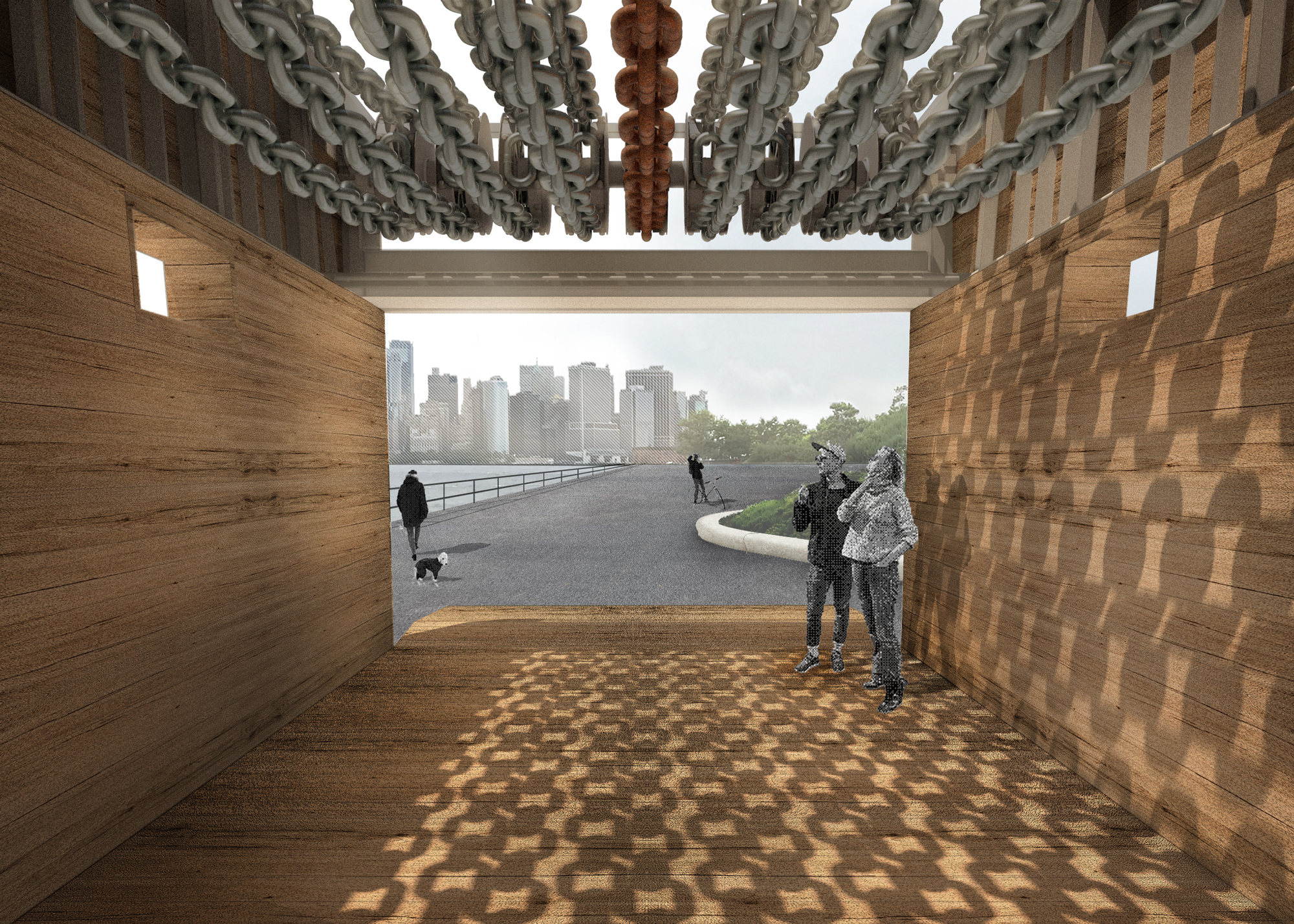
While the individual components of the piece are not technologically unique, the combination of the dynamic chain assemblies and the sound they make within the wooden vessel is novel. The cladding and decking for Moving Chains is made of Sapele, often referred to and marketed as African Mahogany. The wood originates from West Africa, an area where many of the slaves forcibly brought to the US were born. The Sapele sourced for Moving Chains is TLTV certified and documented that the wood was sustainable harvested.
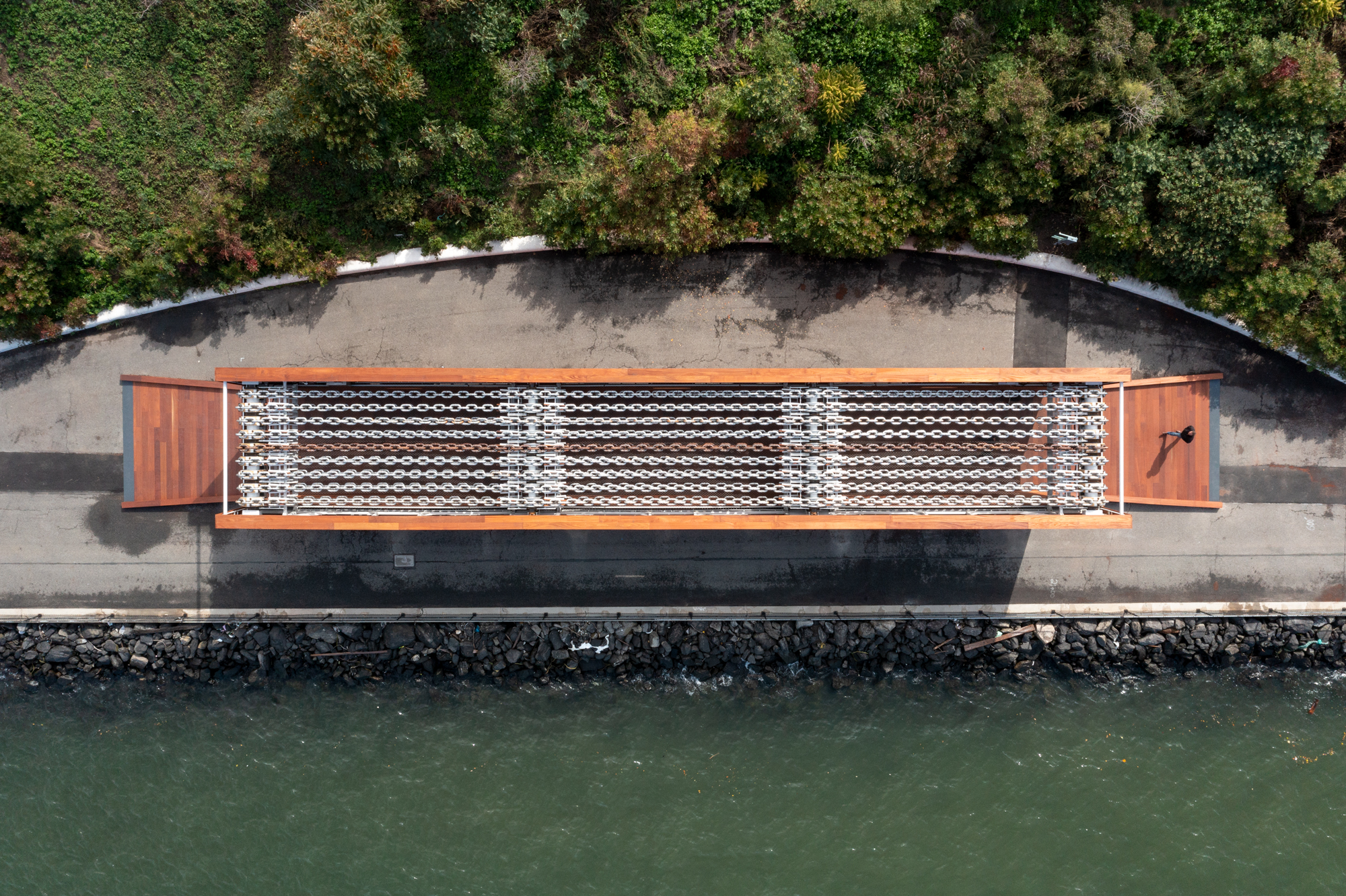
Photograph by Timothy Schenk
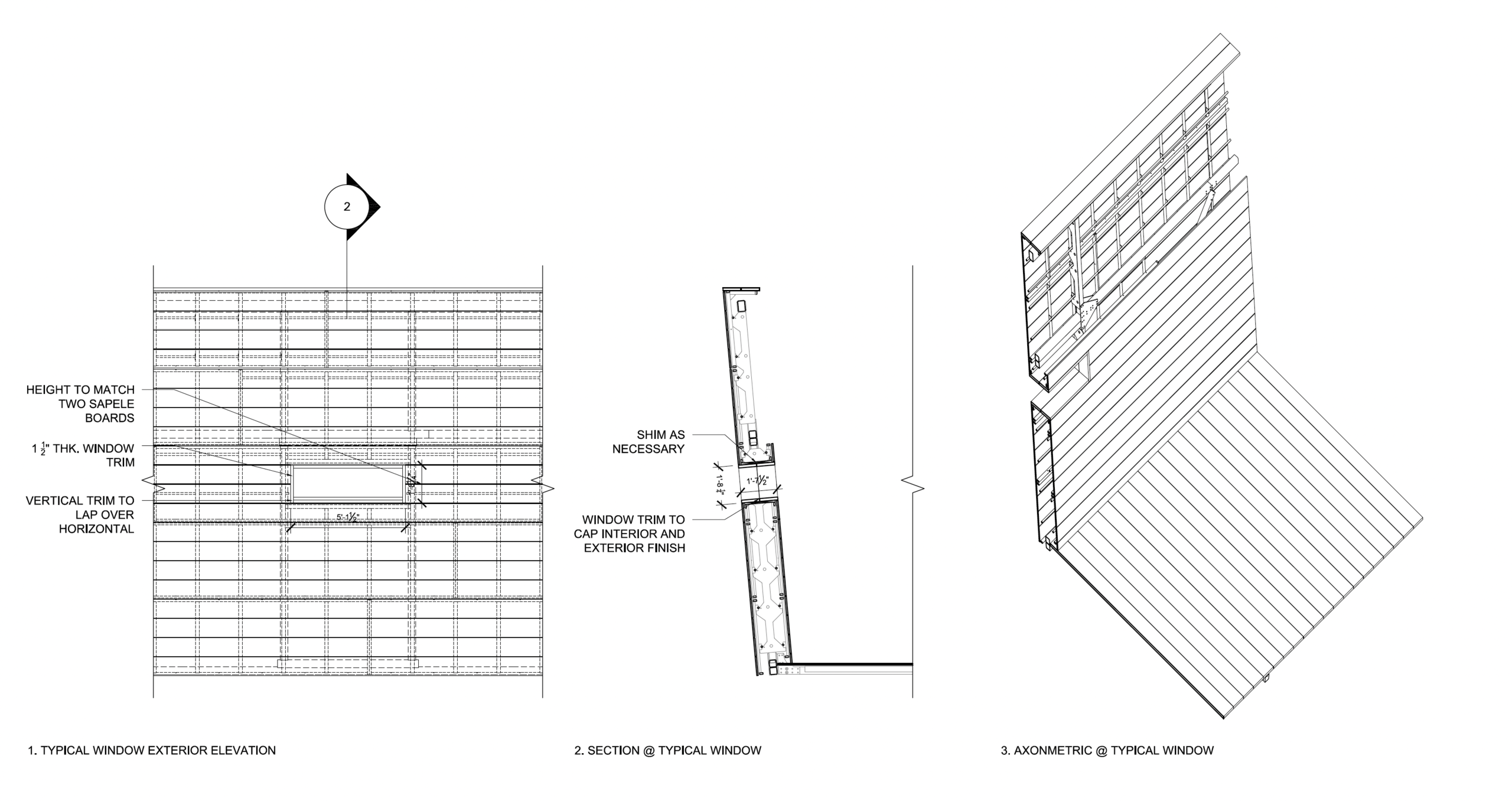
Detail elevation, section and axon of Moving Chains assembly.
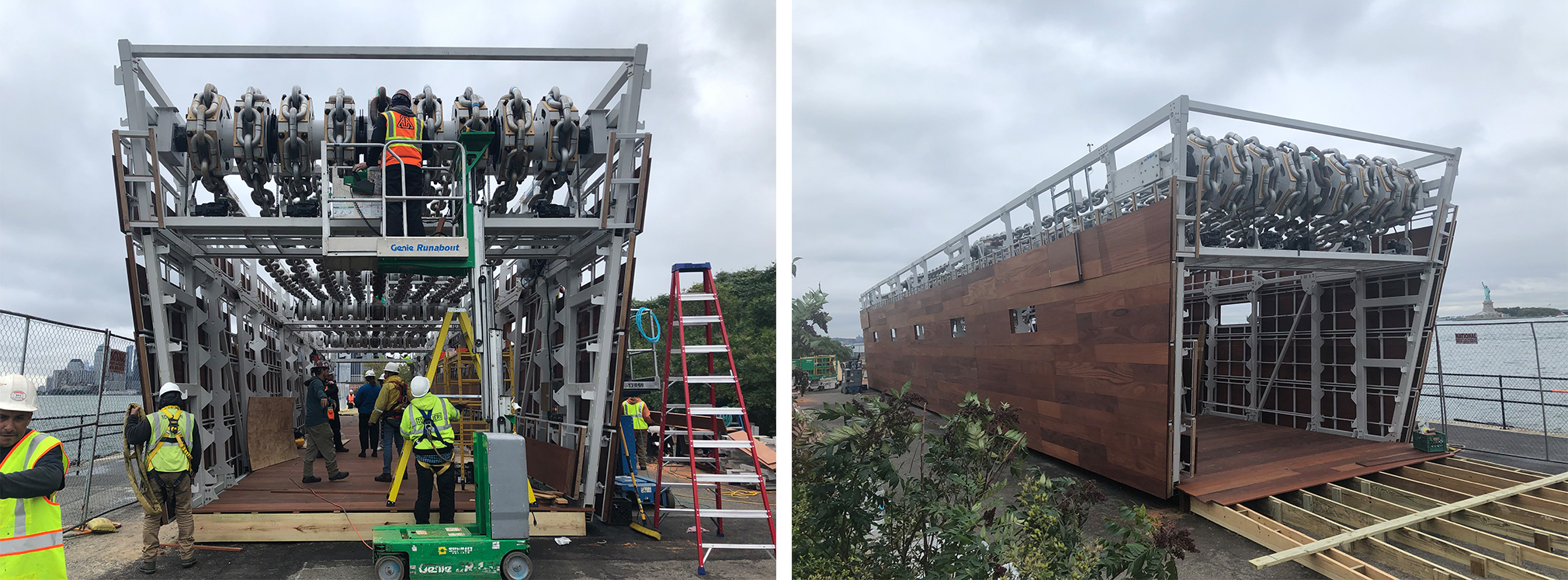
Photographs of "Moving Chains" under construction
In its current realization on Governors Island, it is useful to understand Moving Chain’s original siting and history, as it clarifies the signification of the moving chains, its monumental scale, and its architectural qualities. Below is an account of the first iteration of the project conceived for Saint Louis.
Moving Chains was the largest of a series of artworks conceived in relation to the politically and racially charged historic site conditions contained within the Gateway Arch National Park. The Gateway Arch, designed in 1947 by architect Eero Saarinen, was conceived as a monument to the westward expansion of the United States. Completed in 1965, it is the world’s tallest free-standing arch. Structurally innovative, with its weighted catenary shape and stainless-steel cladding, it is a monument to American post WWII technological ascendancy and optimism. While the Gateway Arch symbolizes the expansion of American culture and civilization it does so without acknowledgment of the free labor and violence that stands in its wake. The Gateway Arch is also implicated in the Dred Scott case, as it defines an axis between the bank of the Mississippi River on the east edge and to the west the Courthouse where the infamous decision was made.
The design for the artwork developed over a series of meetings following a trip Charles took to Saint Louis in preparation for the competition. Charles shared photos he had taken of large rusted anchor chains and of the historic Eads Bridge spanning the Mississippi River. Built in 1867, Eads Bridge was the first large structure to use structural steel, steel that was supplied by Andrew Carnegie’s Keystone Bridge Company. Given the site and wanting to address this imagery, Charles described an artwork that would incorporate both the movement of the river and to reference our country’s reliance on slave labor to move goods along the river.
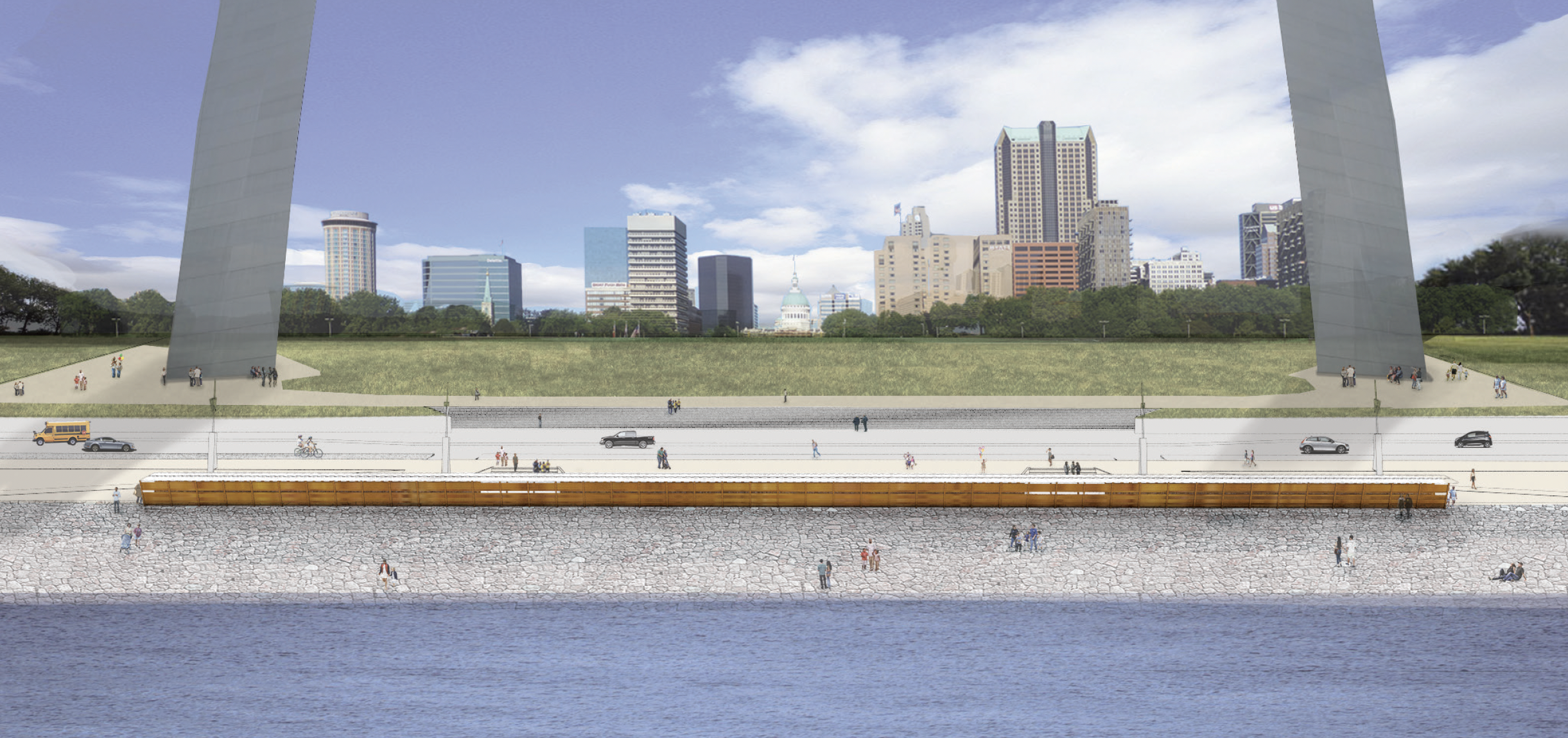
View from river towards Saint Louis' Gateway Arch and original incarnation of Moving Chains installation at its base.
Initially we thought of the piece as a work of sculpture, positioned to be viewed but not to be occupied. At this point the piece was a flat barge, 470 feet in length, containing 11 moving anchor chains. The chains would be visible from above as people headed down to the embarkment from the Arch Grounds above. The center chain would move at the speed of a historic river barge while the outer 10 chains would move at the speed of the river. The immense length of the piece was necessary to stand up to the scale of the arch. As we worked on the project, sketching and 3D modeling, the piece developed into a vessel that could be inhabited. Once it was decided that Moving Chains would be an occupiable, we started to consider its shape and the obvious maritime references.
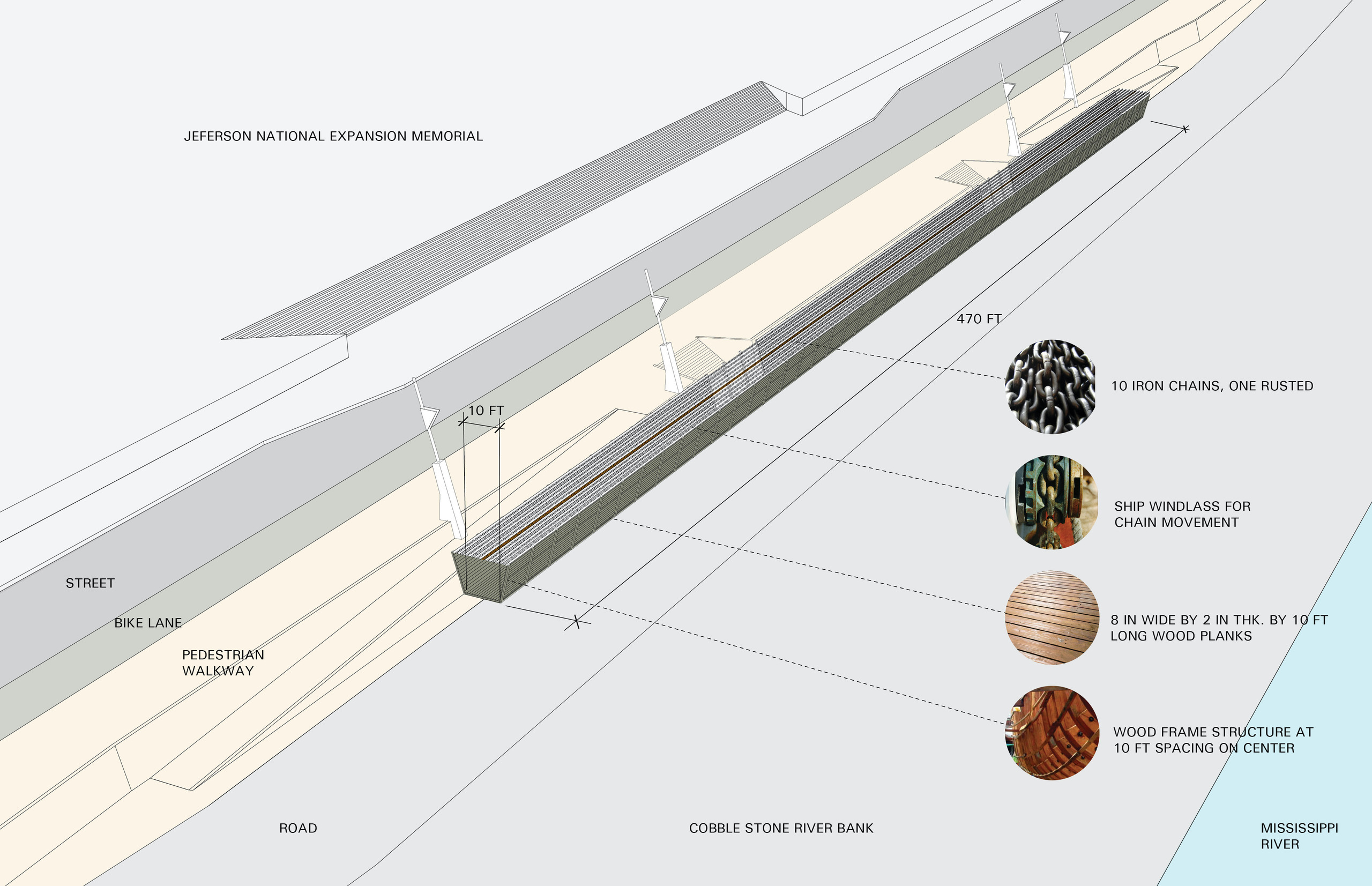
Conceptual diagram explaining components of Moving Chains adjacent to the Gateway Arch.
We were thrilled when Charles Gains, with support from our team, was awarded the commission. While the piece was ultimately not realized in St Louis it has been a fantastic opportunity to work with Charles to further develop the project for its new site on New York’s Governors Island.
Charles Gaines’ Moving Chains, a collaboration with TOLO Architecture,
was commissioned by Creative Time and Governors Island Arts.
Site: Governors Island, NY
Status: Built
Year: 2022
Artist: Charles Gaines, Charles Gaines Studio
Architect Collaborator: TOLO Architecture. Team: Peter Tolkin, Trenman Yau, Sarah Lorenzen, Brittany Jones
Engineering and mechanical design: AOA. Team: Jose Romagoza, Karl Nettmann, Paul Bailey, Jena Dolinar
Installation and build: Torsilieri & Sons. Team: Dean and George Torsilieri
Sound engineering: Arup. Team: Willem Boning
Woodwork and metalwork: Stronghold Industries. Team: Chris Hall.
Others: DucWorks, Utah; Horizon Welding, Nevada; Performance Tube Bending, California; Rozell Industries, New York; and Powerhouse Arts, Brooklyn.
Saint Louis Proposal
Status: Unbuilt
Year: 2014-2015
A project proposal by Charles Gaines in collaboration with Peter Tolkin Architecture
Curated by Meredith Johnson of Creative Time for CityArchRiverArch 2015 & Great Rivers Greenway
Project Team:
Artist: Charles Gaines, Charles Gaines Studio
Architect Collaborator: Peter Tolkin, Peter Tolkin Architecture Inc.
Peter Tolkin Architecture Inc Team: Albert Escobar, Ismaelly Pena, Vaishali Shah
Structural Consultant: Karl Blette, Structural Engineer
Fabrication: Rando Productions, Inc
Fabricator DRED SCOTT TOWER (video): Standard Vision, David Agnew, President
Organizers:
Press:
 Work
Office
Work
Office